12.1 Building on Theory
Learning is rapid. By age 11, some children beat their elders at chess, play music that adults pay to hear, publish poems, win trophies. Others survive on the streets or kill in wars, learning lessons that no child should know. How do they learn so quickly?
Piaget and School-Age Children
concrete operational thought Plaget’s term for the ability to reason logically about direct experiences and perceptions.
Piaget called the cognition of middle childhood concrete operational thought, characterized by new concepts that enable children to use logic. Operational comes from the Latin word operare, meaning “to work; to produce.” By calling this period operational, Piaget emphasized productive thinking.
The school-
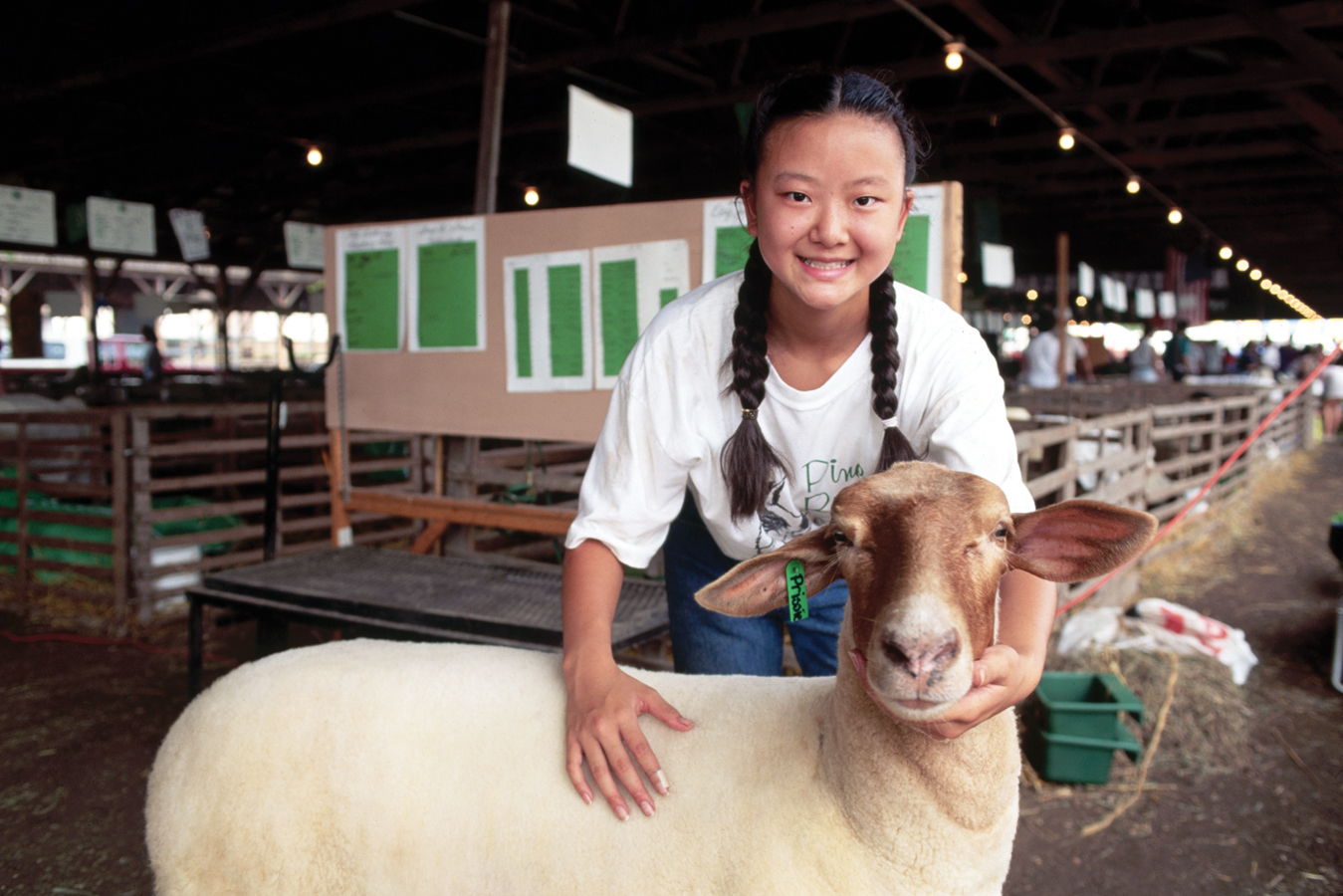
340
A Hierarchy of Categories
classification The logical principle that things can be organized into groups (or categories or classes) according to some characteristic they have in common.
One logical operation is classification, the organization of things into groups (or categories or classes) according to some characteristic that they share. For example, family includes parents, siblings, and cousins. Other common classes are animals, toys, and food. Each class includes some elements and excludes others; each is part of a hierarchy.
Food, for instance, is an overarching category, with the next-
Piaget devised many classification experiments. For example, a child is shown a bunch of nine flowers—
Until about age 7, most children answer, “More daisies.” The youngest children offer no justification, but some 6-
Other Logical Concepts
Several logical concepts were already discussed in Chapter 9 in the explanation of ideas that are beyond preoperational children, such as conservation and reversibility.
seriation The concept that things can be arranged in a logical series, such as the number sequence or the alphabet.
Another example of concrete logic is seriation, the knowledge that things can be arranged in a logical series. Seriation is crucial for using (not merely memorizing) the alphabet or the number sequence. By age 5, most children can count up to 100, but because they do not yet grasp seriation they cannot correctly estimate where any particular two-
Concrete operational thought correlates with primary school math achievement, although many other factors contribute (Desoete et al., 2009). For example, logic helps with arithmetic: Children at the stage of concrete operational thought eventually understand that 12 + 3 = 3 + 12, and that 15 is always 15 (both conservation), that all the numbers from 20 to 29 are in the 20s (classification), that 134 is lower than 143 (seriation), and that if 5 × 3 = 15, then 15 ÷ 5 is 3 (reversibility). [Lifespan Link: These four concepts are explained in Chapter 9.]
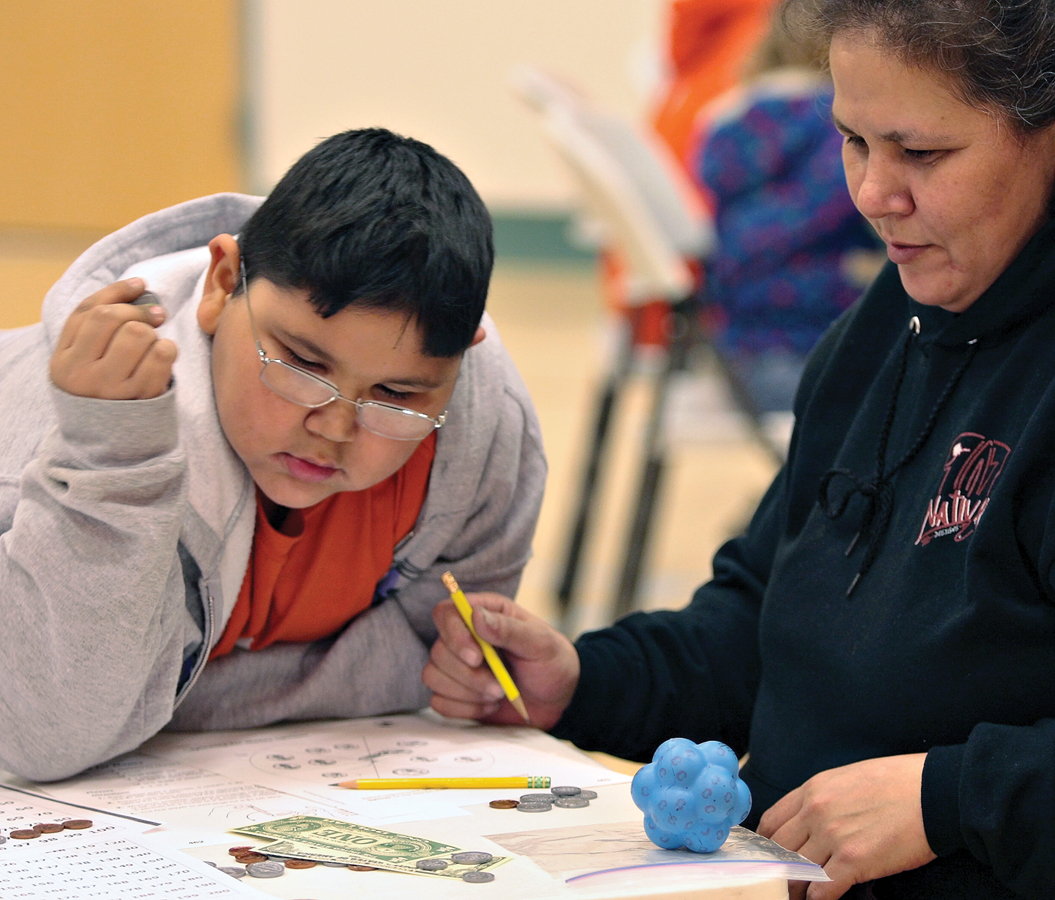
The Significance of Piaget’s Findings
Although logic connects to math, researchers find more continuity than discontinuity as children master number skills. Thus, Piaget’s stage idea was mistaken: There is no sudden shift between preoperational and concrete operational intelligence.
Nonetheless, Piaget’s experiments revealed something important. School-
341
Vygotsky and School-Age Children
Like Piaget, Vygotsky felt that educators should consider children’s thought processes, not just the outcomes. He appreciated the fact that children are curious, creative learners. For that reason, Vygotsky believed that an educational system based on rote memorization rendered the child “helpless in the face of any sensible attempt to apply any of this acquired knowledge” (Vygotsky, 1934/1994, pp. 356–
The Role of Instruction
Especially for Teachers How might Piaget’s and Vygotsky’s ideas help in teaching geography to a class of third-
Response for Teachers: Here are two of the most obvious ways. (1) Use logic. Once children can grasp classification and class inclusion, they can understand cities within states, states within nations, and nations within continents. Organize your instruction to make logical categorization easier. (2) Make use of children’s need for concrete and personal involvement. You might have the children learn first about their own location, then about the places where relatives and friends live, and finally about places beyond their personal experience (via books, photographs, videos, and guest speakers).
Unlike Piaget, Vygotsky stressed the centrality of instruction. For Vygotsky, school can be crucial for cognitive growth. He thought that peers and teachers provide the bridge between developmental potential and needed skills via guided participation and scaffolding, in the zone of proximal development. [Lifespan Link: Vygotsky’s theory is discussed in Chapters 2 and 9.]
Confirmation of the role of social interaction and instruction comes from a U.S. study of children who, because of their school’s entry-
Internationally as well, children who begin first grade earlier tend to be ahead in academic achievement compared to those who enter later, an effect noted even at age 15. The author of this study noted that Vygotsky’s explanation is not the only one, and that these results were not found in every nation (Sprietsma, 2010). However, no matter what explanation is correct, children’s academic achievement seems influenced by social context.
Vygotsky would certainly agree with that, and he would explain those national differences by noting that the education of some nations is far better than others. Remember that Vygotsky believed education occurs everywhere, not only in school. Children learn as they play with peers, watch television, eat with their families, walk down the street. Every experience, from birth on, teaches them something, with some contexts much more educational than others.
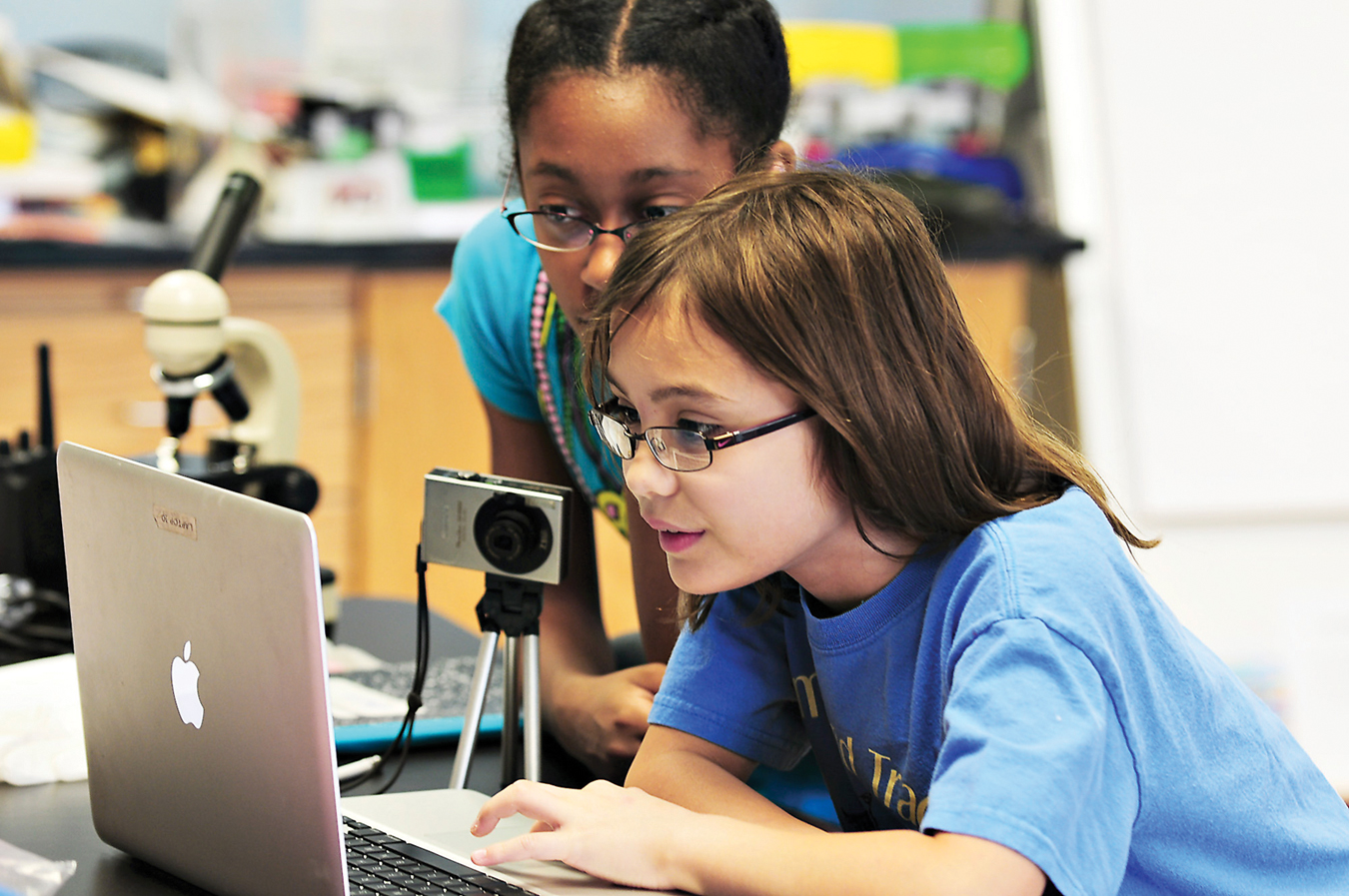
For instance, a study of the reading and math achievement of more than a thousand third-
- Families (e.g., parents read to them daily when they were toddlers)
- Preschool programs (e.g., a variety of learning activities)
- First-
grade curriculum (e.g., emphasis on literacy with individual evaluation)
In this study, although most children from families of low socioeconomic status did not experience all three sources of stimulation, those who did showed more cognitive advances by fifth grade than the average high-
Generally, poverty reduces children’s achievement because they are less likely to have these three. However, for low-
342
International Contexts
In general, Vygotsky’s emphasis on sociocultural contexts contrasts with Piaget’s maturational, self-
The same applies to math. If children learn math in school, they are proficient at school math; if they learn math out of school, they are adept at solving mathematical problems in situations similar to the context in which they learned (Abreu, 2008). Ideally, though, children learn math both in and out of school.
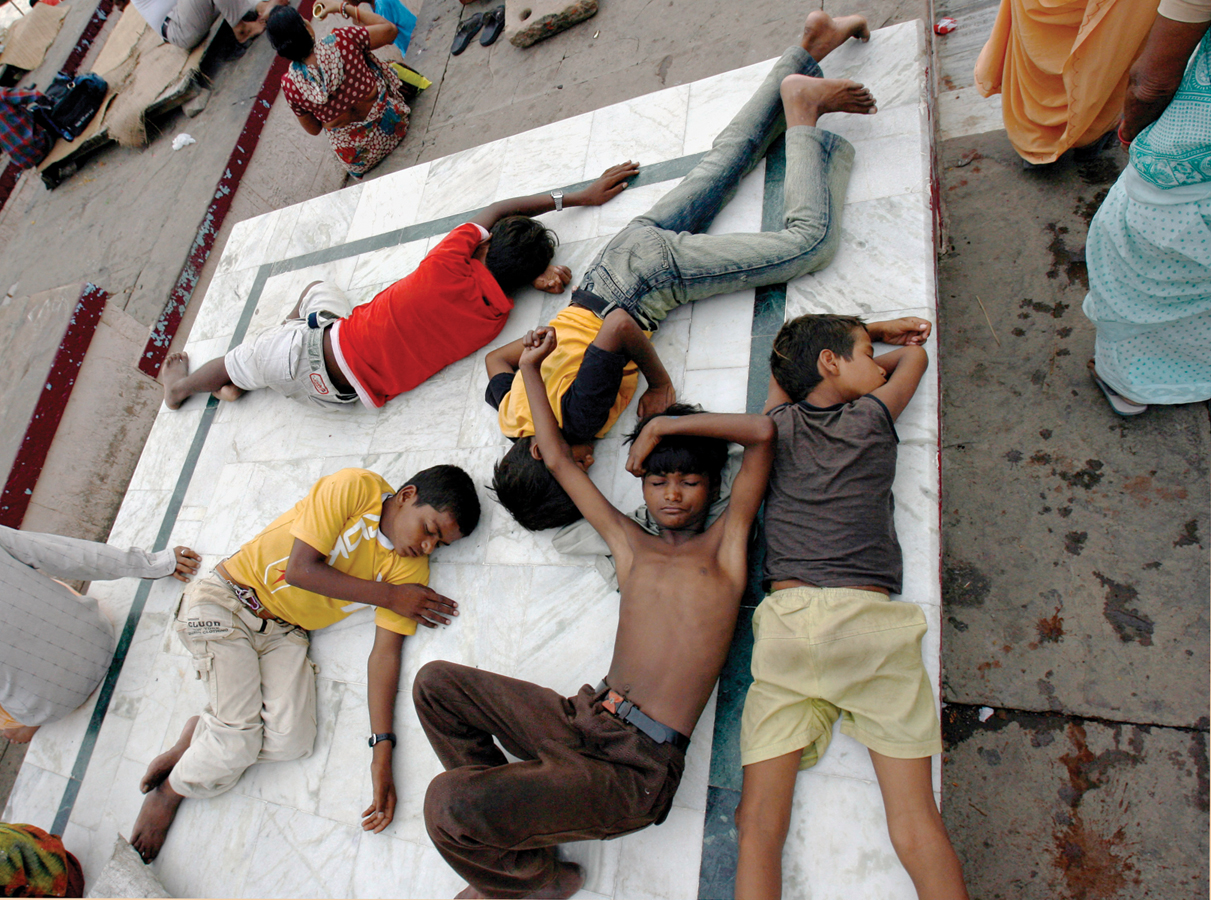
Context affects more than academic learning. A stunning example of knowledge acquired from the social context comes from Varanasi, a city in northeast India. Many Varanasi children have an extraordinary sense of spatial orientation: They know whether they are facing north or south, even when they are inside a room with no windows. In one experiment, children were blindfolded, spun around, and led to a second room, yet many still knew which way they were now facing (Mishra et al., 2009). How did they know?
In Varanasi, everyone refers to the spatial orientation to locate objects. (The U.S. equivalent might be, not that the dog is sleeping by the door, but that the dog is sleeping southeast.) From their early days, children learned north/south/east/west, in order to communicate with others. By middle childhood, their internal sense of direction was acute.
Culture affects how children learn, not just what they learn. This was evident in a two-
In the first session of this study, a Spanish-
A week later, each child individually was told there was some extra material to make the toy that his or her sibling had made the week before, and encouraged to make the mouse or the frog (whichever one that child had not already made.) In this second session, the toy lady did not give the children step-
The purpose of this experiment was to see how much the children had learned by observation the week before. The children from indigenous backgrounds scored higher, needing fewer hints, because they had been more attentive when their siblings made the toy (Silva et al., 2010) (see Figure 12.1).
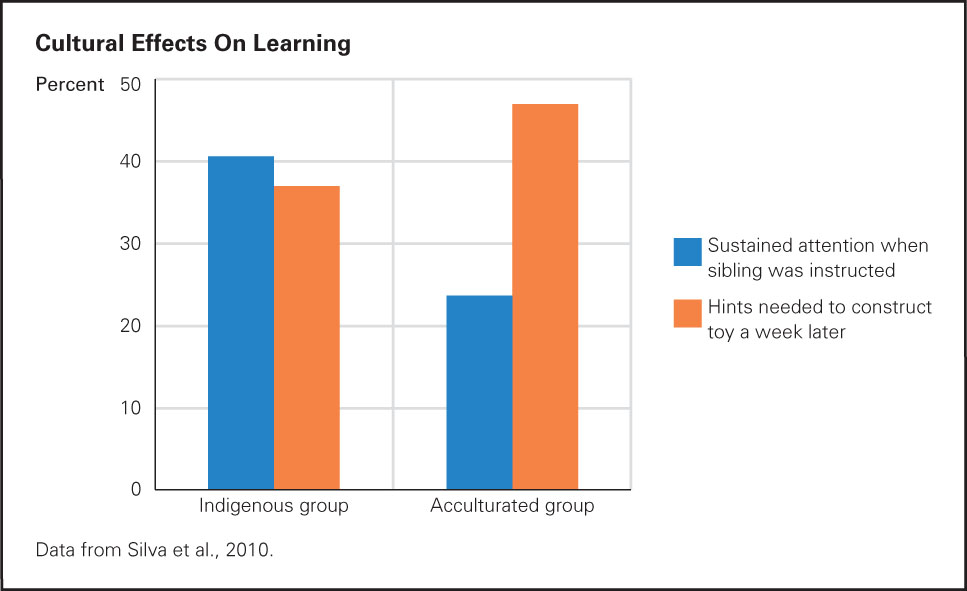
343
The same conclusions have been found in other research. For example, in another study, children born and raised in the United States who are accustomed to learning by observation (as in some American Indian cultures) were more proficient at remembering an overheard folktale (Tsethlikai & Rogoff, 2013).
Information Processing
Today’s educators and psychologists regard both Piaget and Vygotsky as insightful. International research confirms the merits of their theories. Piaget described universal changes; Vygotsky noted cultural impact.
A third, and more recent, approach to understanding cognition adds crucial insight. The information-
Thousands of researchers who study cognition can be said to use the information-
The basic assumption of all those research programs is that, like computers, people can access large amounts of information. They then: (1) seek specific units of information (as a search engine does), (2) analyze (as software programs do), and (3) express their conclusions so that another person can understand (as a networked computer or a printout might do). By tracing the paths and links of each of these functions, scientists better understand the learning process.
The brain’s gradual growth, now seen in neurological scans, confirms the usefulness of the information-
344
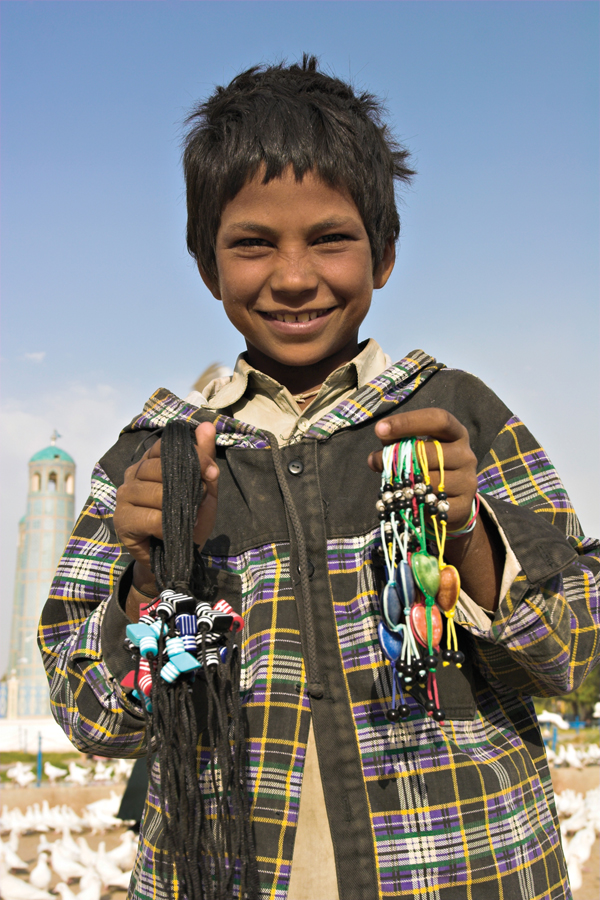
One of the leaders of the information-
Siegler compared the acquisition of knowledge to waves on a beach when the tide is rising. There is substantial ebb and flow, although eventually a new level is reached.
An example is children’s ability to estimate where a number might fall on a line, such as where the number 53 would be placed on a line from zero to 100. This skill predicts later math achievement (Libertus et al., 2013). U.S. kindergartners are usually lost when asked to do this task; Chinese kindergartners are somewhat better (Siegler & Mu, 2008), but proficiency gradually builds from the first grade on, predicting later math skills (Feigenson et al., 2013). This has led many information-
Curiously, knowing how to count to high numbers seem less important for math mastery than these estimates of magnitude (Thompson & Siegler, 2010). For example, understanding the size of fractions (e.g., that 3/16 is smaller than 1/4) is connected to a thorough understanding of the relationship between one number and another (Siegler et al., 2011). Overall, information processing guides teachers who want to know exactly which concepts and skills are crucial foundations for mastery, not only for math but for reading and writing as well.
Memory
Many scientists who study memory take an information-
sensory memory The component of the information-
Sensory memory (also called the sensory register) is the first component of the human information-
working memory The component of the information-
Once some sensations become perceptions, the brain selects the meaningful ones and transfers them to working memory for further analysis. It is in working memory (formerly called short-
| Child’s Age | Memory Capabilities |
|---|---|
| Under 2 years | Infants remember actions and routines that involve them. Memory is implicit, triggered by sights and sounds (an interactive toy, a caregiver’s voice). |
|
2- |
Words are now used to encode and retrieve memories. Explicit memory begins, although children do not yet use memory strategies. Children remember things by rote (their phone number, nursery rhymes). |
|
5- |
Children realize they need to remember some things, and they try to do so, usually via rehearsal (repeating an item again and again). This is not the most efficient strategy, but repetition can lead to automatization. |
|
7- |
Children can learn new strategies, including visual clues (remembering how a particular spelling word looks) and auditory hints (rhymes, letters), evidence of brain functions called the visual- |
|
9- |
Memory becomes more adaptive and strategic as children become able to learn various memory techniques from teachers and other children. They can organize material themselves, developing their own memory aids. |
| Source: Based on Meadows, 2006. | |
As Siegler’s waves metaphor suggests, memory strategies do not appear suddenly. Gradual improvement occurs from toddlerhood through adolescence (Schneider & Lockl, 2008). Children develop strategies to increase working memory (Camos & Barrouillet, 2011), and they use these strategies occasionally at first, then consistently.
Cultural differences are evident. For example, many Muslim children are taught to memorize all 80,000 words of the Quran, so they learn strategies to remember long passages—
345
long-
Finally, information from working memory may be transferred long-
Especially for Teachers How might your understanding of memory help you teach a 2,000-
Response for Teachers: Children this age can be taught strategies for remembering by forming links between working memory and long-
Crucial to long-
Knowledge
knowledge base A body of knowledge in a particular area that makes it easier to master new information in that area.
Research on information processing finds that the more people already know, the more information they can learn. Having an extensive knowledge base, or a broad body of knowledge in a particular subject, makes it easier to remember and understand related new information. As children gain knowledge during the school years, they become better able to understand what is true or not, what is worth remembering, and what is insignificant (Woolley & Ghossainy, 2013)
Three factors facilitate increases in the knowledge base: past experience, current opportunity, and personal motivation. The last item in this list explains why children’s knowledge base is not what their parents or teachers prefer. Some schoolchildren memorize words and rhythms of hit songs, know plots and characters of television programs, or can recite the names and histories of basketball players, and yet do not know whether World War I was in the nineteenth or twentieth century, or whether Pakistan is in Asia or Africa.
346
Motivation provides a clue for teachers: New concepts are learned best if they are connected to personal and emotional experiences. Children who themselves are from South Asia, or who have friends who are, learn the boundaries of Pakistan more readily.
Control Processes
control processes Mechanisms (including selective attention, metacognition, and emotional regulation) that combine memory, processing speed, and knowledge to regulate the analysis flow of information within the information-
The mechanisms that put memory, processing speed, and the knowledge base together are control processes; they regulate the analysis and flow of information within the system. Control processes include emotional regulation and s elective attention (explained in Chapters 10 and 11, respectively).
metacognition “Thinking about thinking,” or the ability to evaluate a cognitive task in order to determine how best to accomplish it, and then to monitor and adjust one’s performance on that task.
Equally important is metacognition, sometimes defined as “thinking about thinking.” Metacognition is the ultimate control process because it allows a person to evaluate a cognitive task, determine how to accomplish it, monitor performance, and then make adjustments. According to scholars of cognition, “Middle childhood may be crucial for the development of metacognitive monitoring and study of control processes” (Metcalfe & Finn, 2013, p. 19).
Control processes require the brain to organize, prioritize, and direct mental operations, much as the CEO (chief executive officer) of a business organizes, prioritizes, and directs business operations. For that reason, control processes are also called executive processes. These processes are evident whenever people concentrate on only the relevant parts of a task, using their knowledge base to connect new information or to apply memory strategies.
Executive processes are more evident among 10-
Both metacognition and control processes improve with age and experience. For instance, in one study, children took a fill-
Sometimes experience is not directly related, but it nonetheless has an impact. This seems to be true for fluently bilingual children, who must learn to inhibit one language while using another. They are advanced in control processes, obviously in language but also in more abstract measures of control (Bialystok, 2010).
Such processes develop spontaneously, as the prefrontal cortex matures, but they can be taught. Sometimes teaching is explicit, more so in some nations (e.g., Germany) than in others (e.g., the United States) (Bjorklund et al., 2009). Examples that may be familiar include spelling rules (“i before e except after c”) and ways to remember how to turn a lightbulb (lefty, loosey, righty, tighty). Preschoolers ignore such rules or use them only on command, 7-
Many factors beyond specific instruction affect learning. For example, if children do not master emotional control in early childhood, their school achievement is likely to suffer for years (Bornstein et al., 2013).
Given the complexity of factors and goals, educators disagree as to what should be deliberately taught versus what is best discovered by the child. However, understanding the early steps that lead to later knowledge, as information processing seeks to do, may guide instruction and hence improve learning. That is one possible conclusion from an interesting experiment (see a View from Science).
347
A VIEW FROM SCIENCE
Balls Rolling Down
Should metacognition be taught, or should children develop it spontaneously when they are old enough? This question has been the focus of decades of research (Lee & Anderson, 2013; Orlich et al., 2009; Pressley & Hilden, 2006). Scholars have considered both “discovery” learning (inspired by Piaget) and explicit teaching (from an information-
The answer depends partly on cultural goals and methods. Some cultures value single-
Most U. S. schools now focus on achievement as measured by tests. That has led to emphasis on instruction and research to support the strategy of explicit teaching. In one study, researchers sought to teach children that a scientific experiment must measure variables one at a time in order to be valid (Klahr & Nigam, 2004). The researchers showed 112 third-
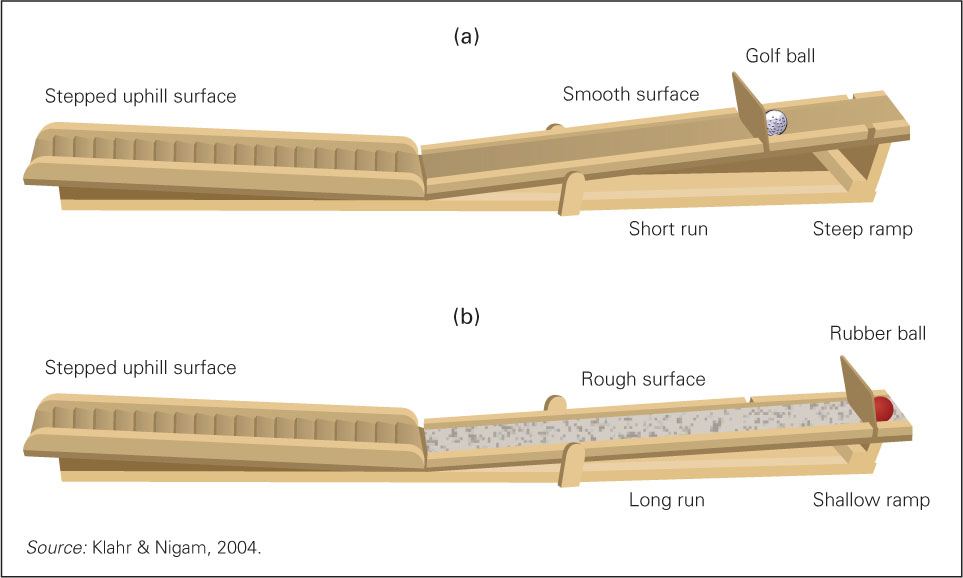
First, the children were asked to design four experiments on their own: two to determine the effect of distance and two to determine the effect of steepness. Only 8 of the 112 children designed experiments that controlled the variables. For example, in an uncontrolled experiment, a child might use a golf ball on a long ramp and a rubber ball on a short ramp. With the variables uncontrolled, the results would be confounded (inappropriately combined).
The 104 children who did not spontaneously control the variables were then divided into two groups. Half were told to continue to create their own experiments; the other half received explicit instruction by watching an experimenter create pairs of demonstrations. For that half, the experimenter asked the children whether a demonstrated pair allowed them to “tell for sure” how a particular variable affected the distance traveled by the ball. After each response, the experimenter provided the correct answer and explained it, emphasizing the importance of testing one variable at a time.
Then all 104 children were asked to design four experiments, as before. Far more children who received direct instruction (40 of 52) correctly isolated the variables than did children who explored on their own (12 of 52).
A week later, those children who seemed to understand (the 40 and the 12) were asked to examine two science posters ostensibly created by 11-
Of course, scientific understanding is about more than understanding variables: It is about questioning conclusions and realizing that answers can and do change. How children develop this ability—
348
A recent experiment involving computer simulation with several classes of German 13-
Many educators fear that the current political climate stresses specific facts, taught explicitly, over broader concepts, grasped by discovery. Psychologists see merit in both strategies, as well as in learning by observation (Lee & Anderson, 2013; Tsethlikai & Rogoff, 2013). What do you think? And, as Vygotsky would ask, “How does your cultural heritage and political persuasion affect your answer?”
SUMMING UP
Every theory of cognitive development recognizes that school-
An information-